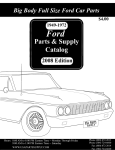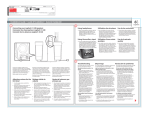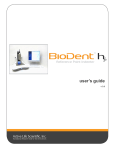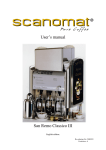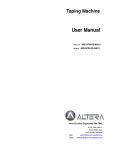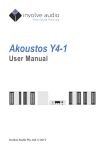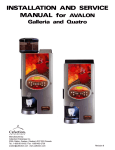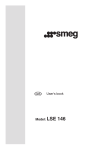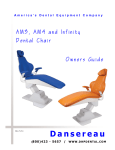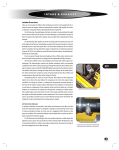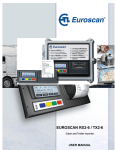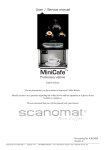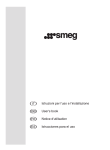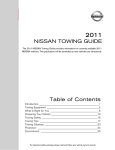Download Service Manual(11.2MB PDF) - Stallion Bus and Transit Company
Transcript
Model: SLC938 Sunliner Coach - Corona, California U.S.A. Sunliner Coach (a Stallion Bus Industries Company) is pleased to provide you, our customer, with the highest quality product available on the market today. We strive to ensure that all our vehicles meet or exceed all applicable Federal, State, and Local laws and statutes for safety and operability for varied on-the-road usage requirements. The vehicles manufactured by Sunliner Coach are constructed with ease of operation and economical durability in mind, for the life of the coach and its operating systems. We take great pride in producing a cost-effective product for your use and for the safety and comfort of your passengers. Every component of this transportation system is vital to the safety and durability of this vehicle and at no time should any system or part be neglected, removed, or altered in any manner that will compromise safety or operability of the vehicle or the safety and well-being of passengers and the operator. It is the responsibility of the owner of this coach to maintain all systems and components in serviceable and working condition. Always maintain and operate this coach with parts and information provided by Sunliner Coach for many years of troublefree driving, and a safe and comfortable travel experience. PLEASE READ BEFORE OPERATING THIS VEHICLE THIS OPERATOR MANUAL MUST REMAIN WITH THE VEHICLE THROUGHOUT ITS SERVICE LIFE, AND MUST BE TRANSFERRED TO ANY FUTURE OWNERS OR OPERATORS AS AN IMPORTANT PART OF THIS TRANSPORTATION SYSTEM. Stallion Bus Industries (“the manufacturer”) will, at its discretion, add to or edit this document as needed to provide the owner with any updates required by law or with information affecting the operation or safety of this coach. Stallion Bus Industries reserves all rights to this document in its entirety, and any copying, duplication, or changes to this manual are strictly prohibited, unless specific permission is granted by the manufacturer to the licensed operator or owner of this coach. Please submit any questions regarding this document to: Stallion Bus Industries 1592 Jenks Dr. Corona, CA 92880 (951) 737-7777 http://www.stallionbus.com THANK YOU FOR CHOOSING STALLION BUS PRODUCTS FOR YOUR TRANSPORTATION NEEDS. GENERAL INFORMATION EXTERIOR COMPONENTS INTERIOR COMPONENTS CONTROLS MECHANICAL TRANSMISSION ELECTRICAL ACCESSORIES / OPTIONS 1- GENERAL INFORMATION Sunliner Coach - Corona, California U.S.A. GENERAL INFORMATION VEHICLE IDENTIFICATION NUMBER (VIN) The Vehicle Identification Number is stamped on a plate located inside the vehicle on the upper step adjacent to the curbside wall. The D.O.T. Certification Plate certifies that the vehicle complies with all Federal Motor Vehicle Safety Standards for operation of a vehicle on public roadways in effect at the time of manufacture. This plate is located on the first step on the aisle side of the driver’s seat. Information such as manufacturer’s name and address, date of manufacture, gross vehicle weight, tire type and pressures, and are also on this plate. Refer to the VIN whenever requesting service parts, recall information. GENERAL INFORMATION The ultimate responsibility for the safe operation of a motor vehicle is the duty of the operator. In the case of motor coach transport, many individual lives may be endangered if certain commonsense items are ignored or dismissed. Due to the nature of tort law and damages compensation law, it is of the utmost importance that you, the operator, take it upon yourself to insure that your vehicle and all of its systems are in operable condition and have been maintained to all pertinent specifications of the manufacturer and state and federal regulations. Before operating the vehicle, be sure to check the following: • Tires – visually inspect for damage, low pressure, or uneven wear. If applicable per your operating agency, check the tire pressures and adjust as required. • Inspect underside of coach for any fluid leaks or damage. Check undercarriage for obstructions and debris. • Make sure that windshield, exterior mirrors, headlights, and windows are clean. • Check all lights (interior, exterior, and instruments) for function • Adjust exterior and interior mirrors for best view from the driver’s position • Walk down the aisle and check for loose items on the seats, stanchions, and overhead storage areas. Secure any loose items before travel. • Check all emergency exits and windows • Inspect for presence and contents of First Aid Kit. • Visually check the fire extinguisher for service pressure and inspection date. • Test the entertainment system and public address system for function. • Check function of lavatory (if so equipped) After starting the vehicle, check the following: • Check for any service lamps or warning lights • Listen for any unusual sounds or engine noise • Adjust seat for best driving position and comfort • Check function of brakes and brake system air pressure • Test air conditioning and heating PRE-TRIP INSPECTION CHECKLIST DATE ________________ MILEAGE: VEHICLE ____________________ START: _________________ END: ____________________ DAILY TOTAL: _________________ INSPECT AND CHECK BELOW: NOTE DEFECTS BELOW: MECHANICAL 1. ENGINE OIL ______________________ __________________________ 2. COOLANT LEVEL _________________ __________________________ 3. WASHER FLUID LEVEL ____________ __________________________ 4. HYDRAULIC OIL __________________ __________________________ 5. BELTS, HOSES ___________________ __________________________ 6. ENGINE GENERAL ________________ __________________________ 7. BRAKES _________________________ __________________________ 8. STEERING _______________________ __________________________ 9. TRANSMISSION ___________________ __________________________ EXTERIOR 1. TIRES __________________________ __________________________ 2. MIRRORS _______________________ __________________________ 3. HEADLIGHTS ____________________ __________________________ 4. TAIL LIGHTS _____________________ __________________________ 5. BODY DAMAGE ___________________ __________________________ 6. WINDSHIELD WIPERS _____________ __________________________ 7. DOORS & WINDOWS _______________ __________________________ SAFETY EQUIPMENT 1. FIRE EXTINGUISHER ______________ __________________________ 2. FLARES _________________________ __________________________ 3. FIRST AID KIT ____________________ __________________________ 4. RADIO __________________________ __________________________ 5. WHEELCHAIR LIFT ________________ __________________________ 6. EMERGENCY EXITS _______________ __________________________ MAINTENANCE ITEMS: _____________________________________________________ FUEL ADDED: _______________ GAL. OIL ADDED: _______________ QT. MILEAGE AT FUELING: ________________ OTHER MAINT.: __________________ -----------------------------------------------------------DRIVER SIGNATURE -----------------------------------------------------MECHANIC SIGNATURE EMERGENCY PROCEDURES In the event of accident, if the vehicle can be moved over to the shoulder of the road or at least out of traffic flow, DO SO IMMEDIATELY. IF SAFE TO DO SO, request that all passengers exit the vehicle and stand away from the vehicle until it is secured. • Make sure that all passengers exit the vehicle in an orderly and safe manner. • Check for injuries among the passengers • If there are any special needs passengers (non-ambulatory, wheelchair-bound), seek help from fellow passengers to remove them from the vehicle. • Triage any injuries – anyone bleeding or unconscious must be attended to first. • Radio or call for medical personnel immediately if there are any injured passengers. • Administer first aid until professional medical help arrives. In the event of fire, get the vehicle out of traffic IMMEDIATELY. • Park in an open area away from underpasses or bridges if possible. • Shut down the vehicle. • Open the doors and make sure that all passengers exit the vehicle in an orderly and safe manner. Direct all passengers away from the vehicle and a safe distance from the roadway. • Call for assistance from firefighters and emergency personnel. • DO NOT ATTEMPT TO PUT OUT AN ENGINE FIRE WITH THE PORTABLE FIRE EXTINGUISHER. This unit is for small, localized fires only. • If possible, turn off the electrical disconnect switch in the engine compartment. DO NOT ATTEMPT TO OPEN THE REAR ENGINE DOOR IF THE VEHICLE IS ENGULFED IN FLAMES. If the vehicle has rolled over or has gone off the road, direct passengers to the doors, emergency exit windows, or roof hatches. Assist all passengers with egress, then call for help. As in the previous sections, triage any injuries and administer first aid until emergency personnel arrive. MAINTEMANCE MANUAL: Refer to Freightliner’s Shuttle Bus Chassis Operator’s and Maintenance Manual furnished with your Sunliner Coach. The follow maintenance operations must be included ; Fastener Torque Checking: Bus Body to Chassis Anchorage fasteners must be torqued at the recommended intervals. Maintenance interval for this operation is M2. Same procedure as 31-01 frame fastener torque checking is to follow, always be sure to check bus frame to chassis rail anchorage at front and back of pass-through luggage compartment. Torque Specifications: Table 5 for ASME Thread Fasteners with dry plain threads. Flanged Grade 8 Bolt , Grade G nut 5/8-11 : 190 lbf-ft ( 258 N-m) Torque Specifications: Table 6 for Metric Thread Fasteners with plated threads. Class 10.9 Bolt , Class 10 Nut M 16-2.0 : 148 lbf-ft (201 N-m) Drive Belt Inspecting: Air Conditioner Compressor and Alternator drive belts must be check at the recommended intervals. Maintenance interval for this operation is M1. COACH CARE & MAINTENANCE CLEANING the cloth after each application. The cleaning information provided in this section is regarded as recommended cleaning practices. Cleaning results will vary depending on the age and condition of the material to be cleaned and the condition of the stain. Always clean stains promptly to prevent setting or etching into the material. Caution: Do not use soap, soap powder, ammonia, bleach, or any cleaning products containing these ingredients. NOTE: Never use stain protection products on new fabrics. To prevent permanent staining of fabrics, clean stains as soon as possible. Incorrect treatment of stains can lead to permanent discoloration or worse staining. Refer to a cleaning specialist for removal of stubborn stains. Caution: Custom fabrics and materials may require different cleaning and maintenance practices. Consult your dealer for specialized cleaning requirements. SEAT UPHOLSTERY Firmly beat the fabric with a wood paddle or similar blunt object to loosen superficial dust and dirt. Vacuum the seat fabric in the direction of the stitching using an upholstery nozzle. Note: The abrasive nature of dirt and dust will reduce fabric life. Always vacuum upholstery regularly. Beverage Stains Remove beverage stains as per method one. If the stain persists, repeat method one using methylated spirits (95% ethanol) in place of solvent. Alcoholic Beverage Stains Remove these stains by wetting the stain with water, then cleaning per method two. Burns Scrape the burned area using a knife or razor blade, the cleaning per method two. Consult an upholstery specialist if the burned area is extensive. Cosmetics Remove stains left by cosmetics by using method one followed by method two. Ink Stains Removal of Stains and Marks Use one of the two methods described below to remove stains from wool plush fabrics: Remove ink stains by following method two. If stain persists, apply a warm oxalic acid solution. Rinse thoroughly with lukewarm water. Method One: 1. Apply a non-flammable solvent, such as drycleaning solvent (Perchloroethylene) to the stained area with a clean white rag. Blood, Urine, or Vomit Remove by sponging or wiping away excess solid matter first. Then clean per method two. 2. Wipe the stain, starting at the outer edges and working inward, frequently turning the cloth. Copying Ink / Ball-Point Pen Ink 3. Blot the stained area frequently with a dry white cloth to prevent stain rings from excess solvent. Warning: Use solvents in a well-ventilated area, away from ignition sources and open flame. Keep all windows and doors of the vehicle being cleaned open – use appropriate breathing apparatus or fume masks. Treat with methylated spirits, blotting frequently to prevent stain spread, followed by method two. Felt-Tip Pen Ink / Permanent Marker Ink Wipe thoroughly with a clean cloth soaked in MEK, followed by method two. Method Two: 1. Wet the stain with a solution of household detergent and lukewarm water. Do not flood or over-soak the stain. 2. Wipe the stain with a damp cloth, rinsing Oil, Grease, and Paint Remove excess using a knife. Treat per method one followed by method two. Repeat if stain persists. COACH CARE & MAINTENANCE STAINLESS STEEL Rust Remove per method two. Apply a warm oxalic acid solution to the stained area. Rinse with water. Use a stainless steel cleaner and follow the manufacturer’s directions. AVOID using abrasive pads or steel wool to clean stainless steel surfaces. Tar FORMICA Soften tar with benzene or naphtha. Treat per method one followed by cleaning per method two. Chewing Gum Scrape excess with spatula. Soften remainder with cyclohexane. Carefully scrape off stains with a sharp knife or razor blade. PLASTIC AND VINYL Clean plastic and vinyl surfaces with a clean damp cloth or sponge. DO NOT use cleaners or polishes on chromed plastic trim. For marks on vinyl trim, use a lukewarm all-purpose cleaner or a MILD saddle soap. Remove water spots and soap traces with a clean damp cloth, chamois, or sponge. Dry with a clean soft cloth. Remove grease, tar, or oil stains with a clean cloth or sponge and an all-purpose vinyl cleaner. Formica surfaces may be cleaned with a solution of warm water and household detergent; methylated spirits, or mineral turps. Clean with a mild abrasive and water solution (scouring powder) if needed. CARPET Vacuum carpeting regularly to prolong carpet life. Clean per manufacturer’s instructions. Natural-fiber carpet, polyester / nylon carpet, and synthetic (plastic) carpeting each are cleaned and de-stained in different ways. Always consult manufacturer’s recommendations first before attempting removal of any stain from fiber / woven flooring materials. RUBBER Only use purified water or glycerin to remove stains from rubber components. NEVER use solvents or detergents on natural or synthetic rubbers or foam. Apply a colorless vinyl or leather protectant to maintain luster and pliability of the plastic material. Note: After cleaning rubber with a moistened cloth or sponge, apply a thin layer of rubber protectant to maintain suppleness and weather resistance. WINDOWS / GLASS SURFACES FLOORING Clean glass surfaces and the inside of windows with a solution of 10% vinegar in purified water. Wash the floor regularly to maintain its original texture and appearance. Clean vinyl floors with manufacturer’s recommended non-ionic cleaner or household all-purpose cleaner. Encrusted oil stains or rubber streaks may be removed with thinner. WINDSHIELD To prevent wiper streaking, keep all silicone sparys away from the windshield. Remove road film, insect residue, and wax buildup from windows with lukewarm soap and water solution or an alcoholbased liquid cleaner. If a chamois is used for wiping or polishing glass, it must only be used for glass surfaces. Remove excess detergent solution with a wet/dry vacuum or mop. Rinse floor with a 10% solution of liquid laundry bleach and warm water. Polish dry floor with a high-speed buffer equipped with a red Scotchbrite™ pad. Mop floor periodically with a 5% solution of household liquid bleach and warm water. Wiper Blades In cold weather conditions, loosen wiper blades from windshield to prevent tearing. Periodically remove wiper blades and clean the rubber with an alcohol-based cleaner. Wipe dry with a clean cloth or sponge. VEHICLE EXTERIOR The exterior finish of any vehicle is subject to damage from pollutants and abrasive airborne particles. Frequent washing and waxing of the exterior will protect the finish and luster of painted surfaces. COACH CARE & MAINTENANCE Install keyhole protectors to prevent water penetration. Rinse off vehicle with water to remove loose dirt. Wash vehicle with a quality car wash soap, using a sponge or cotton mitt. Rinse off thoroughly with water. Dry with terry towels or chamois. NOTE: Always use cool water for rinsing and washing. Hot water can damage paint and plastic trim. The optional top tank holds 13 gallons and the lower tank holds 13 gallons . The sump tank may be equipped with a heating element to prevent freezing during cold weather. Routine draining and filling of lavatory tanks should be done prior to parking the vehicle overnight in freezing weather. NOTE: When using high pressure washers, do not spray directly into fresh air vents or radiator or condenser doors. High pressure water jets can damage or perforate condenser cooling fins. Wash the undercarriage with a high-pressure washer to remove caked-on dirt and road salt. Thoroughly clean the inner fenders, wheel interiors, bumpers, exhaust system, and any exposed brackets. Spray underside of vehicle first and allow to soak before cleaning. Exhaust system must be cool before cleaning. 3 Perform corrosion prevention treatment per manufacturer’s recommendations at least every two years. 2 Oil, Tar, Asphalt Stains Remove tar and oil stains as soon as possible with an approved automotive tar remover or naphtha. Clean the area with car wash soap and water. Dry, then wax with quality automotive protectant wax. Insect Residue / Bird Droppings Remove insect stains and bird droppings immediately to prevent etching of painted surfaces and discoloration of plastics. Use lukewarm water and mild car wash soap or commercial bug / tar remover for insect residue. Follow with a quality wax to protect cleaned areas. Tree Sap Wash off immediately with lukewarm soap and water. Do not allow tree sap to harden on painted surfaces or rubber / vinyl trim. LAVATORY MAINTENANCE Lavatory with recirculated system Flush water in the lavatory is recirculated from the sump tank. If two tanks are used, the upper tank is the primary sump and the lower tank is the auxiliary sump. When the main sump tank water is too soiled for recirculation, the driver can dump it into the auxiliary tank until a suitable dump location can be reached. The main sump tank is then filled with fresh water to begin the cycle again. 1 123- Water inlet connector Pressure tank Dump valve COACH CARE & MAINTENANCE (cont.) FILLING THE SUMP TANK Fill the sump tank to half capacity through the water inlet connector and throw in a packet of commercial toilet deodorant thru lavatory toilet. DRAINING THE SUMP TANK Drain the sump tank once recirculating water in the toilet is soiled. If equipped with the optional auxiliary sump tank, drain the lower sump tank contents first by opening it’s knife gate valve, then drain the upper tank. Caution: Lavatory tanks should be serviced only at suitably equipped stations. Warning: It is illegal to dump sump tank contents in any location other than a designated service dump station. When a complete tank draining is required, clean main tank by repeating the draining and filling operations with the drain valves open. Once done, close the valves and drop in a packet of commercial toilet deodorant into the toilet before starting the final filling of the main tank. Warning: The toilet deodorant package contains chemicals that will irritate the skin. Use rubber gloves when handling. Caution: When cold weather is expected, both sump tanks must be drained if the coach will be parked overnight or for an extended period of time. Note: Due to the heat it produces, there is less likelihood of the tanks freezing while the engine is on. Note: Sump tank may be equipped with an optional intank heater that automatically comes on when the temperature of the water drops below 35°F (2°C), or a thermal valve that automatically opens the drain valve at the same temperatures. COACH CARE & MAINTENANCE (cont.) Wheels and Tires It is of utmost importance that tires are kept inflated to their respective recommended pressure at all times. Tire pressure should be checked before starting the day’s run, while the tires are cold. Maintaining the tires at recommended pressure will lengthen the life of the tires and will insure safe travel and even tire wear. Note: Recommended inflation pressures are part of the Coach Final Record found in the Maintenance Manual provided for your coach. The cold tire inflation pressures are on the DOT Certification Plate. Warning: Do not exceed maximum inflation pressure. Incorrect tire pressure hastens tire wear and could lead to loss of driving control. Warning: If replacement tires are different from those described on the vehicle certification plate, adjust pressure to specifications listed in the Tire and Rim Association Manual. If coolant level is low, fill surge tank with a 50-50 mix of ethylene glycol antifreeze and water. Refer to the vehicle maintenance manual for further information. Warning: Hot engine coolant is under pressure. Do not open the coolant filler cap when the engine is hot. Allow the engine to cool before adding coolant. Wheel Bearings Check wheel bearing covers for overheating during fuel stops by touching the bearing caps. If excessively hot, refer to service personnel. Windshield Washer Reservoir Check washer reservoir level. Add antifreeze washer fluid for cold weather service. Engine Oil Doors Open, then close all exterior doors and windows. Check for tightness and good sealing. Check engine oil level with vehicle parked on flat ground. Engage parking brake whenever checking items in the engine compartment. Belts Tools and Spares Make sure the vehicle is equipped with the following: a wheel nut wrench, door keys, reflectors, a jack, and a serviceable fire extinguisher. Inspect belts for looseness (noise) or cracking and fraying. Belt tension may be checked with a pressure gauge – refer to maintenance manual section on engine service. Air System Fire Extinguisher(s) Drain water from main and accessory air tanks daily. If the vehicle is supplied with an automatic drain valve, assure it is functioning correctly after the system has reached full pressure. See your maintenance manual. Inspect fire extinguishers for correct service pressure and current inspection tag. Emergency Exits Fuel / Water Separator Open the drain valve on the bottom of the water separator daily. Close valve after service. Coolant Level Check coolant level. Level is correct when visible at the level window of the surge tank. Check all emergency exits (doors, windows, roof hatches, etc.) for correct operation and serviceable condition. 2- EXTERIOR COMPONENTS Sunliner Coach - Corona, California U.S.A. EXTERIOR COMPONENTS FRONT AND STREET SIDE 17 1 16 15 14 2 13 3 9 4 1. Front Identification Lamps 5 6 (Yellow) 7 10 11 12 8 9. Front Side Turn Signal 2. Side View Mirrors (Left & Right) 10. Side reflector / marker lamp (Yellow) 3. Fog Lights 11. Luggage Compartments (3), Streetside 4. High Beam Headlights 12. Radiator Access Door 5. LED Parking Lamps 13. Side reflector / marker lamp rear (Red) 6. Low Beam Headlights 14. Side Marker Lamp, Rear (Red 7. Front Park / Turn Lamps 15. Side Marker Lamp, Center (Yellow ) 8. Main Electrical Compartment 16. Side marker Lamp, Front(Yellow) 17. Front Clearence lamp, Front(Yellow) EXTERIOR COMPONENTS REAR 9 8 7 1 2 3 4 5 6 1. High-Mounted Brake Lights 4. Rear red reflectors 2. Rear View Camera 5. Engine Compartment Door 3. Rear Lamp Assemblies: 6. Rear License Bracket & Lamp Taillights 7. Rear Clearance Lamps (Red) Turn Signals 8. Rear Identification Lamps (Red) Back-Up (Reverse) Lamps 9. Vent ( lavatory-equipped models) Brake Lights EXTERIOR COMPONENTS CURB SIDE 1 2 15 3 4 14 5 13 6 7 12 11 9 10 8 1. Side marker Lamp, rear (Red) 9. Reflector / marker , Front (Yellow) 2. Reflector / marker , Rear (Red) 10. Entry Door 3. Preheater Compartment Door 11. Side marker Lamp, Front (Yellow) 4. Battery Compartment Door 12. Roof Hatch w/Fan, Forward 5. Reflector / marker , Center (Yellow) 13. Side marker Lamp , Center(Yellow) 6. Luggage Compartments (3), Curbside 14. Roof A/C Unit 7. Fuel Filler Door 15. Roof Hatch w/Fan, Aft 8. Side Turn Signal, Front ENTRY DOOR 2 1 Main Entry Door (1) and Door Lock (2) 4 3 2 The entry door may be locked and unlocked manually by inserting the door key into the door key switch (3), turn the key to the right (clockwise) then turn the door handle (2) to the left (counterclockwise) to unlock. Turning the handle to the right (clockwise) will lock the door . Turn the key to its original position and remove the key. When the door is unlocked, you can opened it or closed it, through the use of the keychain remote control provided with the vehicle or by inserting the door key into the door key switch (4). This remote is a battery-powered radio-frequency device that transmits a short-range signal to the vehicle’s door open / close mechanism. See next page for details of operation. NOTE: The use of the Key Fob or Key Operated Entry Switch DOES NOT lock or unlock the door. ENTRY DOOR (Continued) Door Remote The door remote control unit has two functions – CLOSE and OPEN. To access the function buttons, slide the protective cover downward to expose the two buttons. Press the right (UNLOCK) button once to open the door. To close the door, press the left (LOCK) button once. Each time either button is pressed, the red LED at the top of the remote will light. Should the lamp fail to illuminate when the buttons are pressed, the battery will need to be replaced. The door can only be locked or unlocked manually with the key . To replace the remote battery, carefully pry open the side of the remote case. The battery (#2032) is located in the front (button side) of the case interior. Remove the old battery and fit the replacement cell into the battery cavity with the positive (+) side of the battery facing downward. Press the case halves back together and press a button to check function. EMERGENCY DOOR RELEASE In an emergency, the door may be released from the interior of the vehicle by turning the red emergency air release knob clockwise (rigthwise). The air release valve is located above the first step on the curbside of the bus. Note: An other manual door release valve is located underneath the vehicle next to the step. CARGO STORAGE 1 Front Streetside Cargo Compartment 2 3 Curbside Cargo Compartment Doors Three (3) doors on each side of the bus access the cargo / storage compartments. The forwardmost doors on each side are smaller separate compartments from the large pass-through compartment that is accessed by the center and rear doors on each side. The forward curbside cargo compartment contains the tools for changing the spare tire. the forward street-side compartment house electrical components and the windshield water reservoir. To open the compartment doors, pull out and up on the door handle and allow the door to rise upward. CAUTION: When closing the doors, BE SURE to keep fingers away from the door edges and inner frame. Stand slightly back from the door and press downward on the outer face of the door to close. The door edges can be pinch points for hands and feet. SPARE TIRE SPARE TIRE Spare Tire Location (1) The spare tire is located underneath the vehicle, behind the front bumper. TIRE GEAR BOX ACCESS TIRE CRANK To access the tire, it must be lowered from its stowed position. The tire is secured in it’s location by two 1- 5/16” Gr 8 nuts and the gearbox chain. Once the nuts are removed, the tire hangs on the chain mechanism. A crank is used to turn the mechanism and lower the tire. Lower the spare tire by removing the crank from its stowed position in the forward curbside storage compartment. Remove the gearbox access port cover at the step below the driver’s seat. Insert the pinned end of the crank through the hole and into the mechanism receptacle. Remove the1-5/16” security nuts then turn the crank counterclockwise (left) until the tire is on the ground. Remove the chain end from the center of the wheel and bring the tire out and away from the vehicle. Reverse the above steps to stow a tire under the vehicle. Note: Make sure the tire is stowed securely (not loose and nuts tight) before driving away. 3- INTERIOR COMPONENTS Sunliner Coach - Corona, California U.S.A. DRIVER SEAT 11 6 7 10 9 1 8 2 3 4 5 DRIVER SEAT CONTROLS The driver’s seat is a pneumatically-adjustable air-suspension seating system that will accommodate a wide variety of operator physiques and that can be adjusted for extreme comfort by most users. When getting ready to operate the vehicle for the first time, set the seat controls for best viewing height, and then proceed to adjust the auxiliary functions such as seatback angle, cushion rake angle, lumbar support, and suspension stiffness. Always set the seat for the safest and most comfortable position for operating the vehicle and being able to access all controls and pedals. 1. Seatback Angle Adjuster – pull upward, adjust seat then release. 2. Side Bolster Adjustment – Increases or decreases the side bolster stiffness 3. Lumbar Support Adjustment – Center of back 4. Lumbar Support Adjustment - Upper and lower back 5. Seat Height Adjustment – Push upward to raise seat height, downward to lower. 6. Suspension Stiffness – Slide backward to soften suspension, forward to stiffen. 7. Air Lock / Release – Push downward to deflate seat. 8. Seat adjustment forward / backward – pull upward, adjust seat then release handle. 9. Seat bottom adjustment forward /backward- pull upward, adjust seat then release. 10. Seat inclination adjustment- pull upward, adjust seat then release. 11. Armrest Adjuster – Rotate knob to achieve proper armrest angle. DASHBOARD The instrument cluster, steering wheel, switch cluster, and warning lamp cluster are located directly in front of the driver. This area comprises the main information and control center for the operator. 2 3 1 4 5 7 8 6 1. Switch cluster #1 7. Steering wheel 2. Instrument Cluster 8. Multifunction stalk 3. Warning lamps cluster 4. Rear view camera monitor 5. Ignition Switch 6. 12V Power socket INSTRUMENT CLUSTER 9 8 1 7 3 4 5 6 2 1. Tachometer 7. Speedometer 2. Air Pressure – Main Tank 8. Service Information Display 3. Oil Pressure 9. Warning Lamps (Left & Right sides of Lamp / Diagnostic panel) 4. Coolant Temperature 5. Fuel Tank Level 6. Air Pressure – Auxiliary Tank CONTROLS CONSOLE The driver’s controls console is located on the left side of the driver’s compartment, below the roadside front window. Most of the major controls for the vehicle are situated within easy reach of the operator at this location. 4 5 3 2 6 1 7 8 9 10 11 12 1. Interior climate controller (A/C) 7. Switch clusterl #2 2. Parking Brake 8. Side storage pocket 3. Service Information Display Menu Switch 9. Luggage compartment lights 4. Transmission shift control 10. Windshield defroster fan and heat 5. Auxiliary heater ON/OFF switch 11. Exhaust brake ON/OFF 6. Mirror controls 12. Cup holder 13- Manual regeneration switch ( Exhaust Aftertreatment) Engine EPA 2007 13 A flashing AFTERTREATMENT DIESEL PARTICULATE FILTER lamp indicates that the aftertreatment diesel filter needs to be regenerated at the next possible opportunity. Engine power may be reduced automatically. When this lamp is flashing, the operator should: 1- Change to more challenging duty cycle , such as highway driving , for at least 20 minutes. 2- Perform a stationary regeneration. Follow all instructions from Cummins Owners Manual ISB 6.7L CM2150 furbished with your Sunliner Coach Bus ( pag, 1-19 to 1-25) bulletin 4021601. STEERING WHEEL 1 1 2 The steering wheel and column are adjustable for steering wheel angle and overall column height. The center pad on the steering wheel can be pressed at the upper outside edges (1) or at the center (2) to activate the horns. NOTE: Do not turn the steering wheel all the way to the right with the entry door open – the right front tire will contact the door frame if the wheels are fully turned to the right. 3 4 The steering column height is adjusted with the lever (3) on the left side of the steering column, below the steering wheel. Pull up on the lever, then pull up or push down on the steering wheel to set the best height for the operator. Release the lever to lock it back into position. Adjust the steering wheel angle by pressing down on the pedal (4) at the base of the column. Move the steering wheel into the best position and release the pedal to lock into position. NEVER adjust the steering while the vehicle is in motion or under power. CLIMATE CONTROL 3 1 2 5 4 6 7 ThermoKing™ Climate Control Panel The vehicle’s interior environment is managed by the ThermoKing™ Controller located on the side control console. The controller functions by balancing heat, cooling, airflow, and intake air for maximum comfort. 1. Power (On / Off) 2. Display Selector (Off / On / Interior Temp. / Exterior Temp.) 3. Display 4. Cooling / Heating Selector (Off / Heat / A/C) 5. Fan Speed (Low / Medium / High) 6. Vent Position (Closed–Recirculate / 1/2 / Full Open) 7. Temperature Level (Blue zone = colder, Red zone = warmer) Note: Do not power ON the A/C unless the engine is running. 4- CONTROLS Sunliner Coach - Corona, California U.S.A. SWITCH CLUSTER #1 2 1 2 4 3 5 3 10 6 9 7 8 1. Microphone Jack 7. Windshield Wiper – High speed 2. Overhead lighting – Right / Left 8. Windshield Washer spray 3. Floor Heaters – Right / Left 9. Left windshield visor control 4. Driver’s Lights power 5. Seat Belt warning lamp - driver 6. Windshield Wiper – Low speed 10. Right windshield visor control SWITCH CLUSTER #2 2 4 3 1 8 7 5 1. Power Vent Fan Switch 2. Reading Lamp Power Switch 3. Front Video Screen Power 4. Front Video Screen UP/DOWN 5. Rear Video Screen Power 6. Rear Left Video Screen UP/DOWN (optional) 6 7. Rear Rigth Video Screen UP/DOWN (optional) 8. Not Used (Optional Lamps) IGNITION SWITCH The ignition switch is located on the lower right side of the dashboard. It has four positions: 1. ACCESSORY This position is the furthest left (counterclockwise) position of the switch. It allows use of the electrical items connected thru this option; the entertainment system, interior and exterior lighting, clock / thermometer, and P.A. system. 2. OFF When the switch is in the OFF position, all electrical devices except those directly connected to the battery (coolant heater, emergency flashers, etc.) are unpowered. The ignition key can be inserted or removed only when the switch is in this position. 3. ON All electrical systems are activated. The key cannot be removed in this position. If the engine is not running, do not leave the switch in this position if the engine is not running for extended periods of time. Doing so will drain the batteries. 4. START This position is the furthest right (clockwise) position of the switch. It is a momentary position for engaging the engine starter to crank the engine. Release the key as soon as the engine starts. Do not crank the engine continuously for more than 10 seconds. If the engine does not start, wait 30 seconds before attempting to restart. PARKING BRAKE The parking brake is a pneumatic control switch (1) located on the left-hand driver’s control console. To apply the parking brake, make sure the vehicle is stopped, the transmission is in neutral, and the service air pressure is within operational limits. Pull upward on the button to activate the brake, push it downward to release the brake. 1 The parking brake will not release unless the vehicle’s primary air pressure supply is above 60 PSI. Should air pressure fall below 60 PSI, the LOW AIR alarm will sound. The parking brake will be automatically set once air pressure falls below 45 PSI. The vehicle’s brakes will remain locked until service air pressure is restored. DO NOT set the parking brake while the vehicle is in gear. Always stop the coach and shift into neutral before setting the parking brake. NEVER use the parking brake in place of the service brake. If it is necessary to leave the driver’s seat, place the transmission in neutral, set the parking brake, and turn the engine off. Warning: FOOT APPLICATION – BREAKE PEDAL – SHOULD ALWAYS BE APPLIED WHEN RELEASING AND APPLYING THE PARKING BRAKE HEADLAMP SWITCH HEADLIGHT SWITCH AND INSTRUMENT LIGHTING The headlight switch is a dual-switch setup, incorporating exterior lighting with instrument illumination in one location. The switch is on the left side of the dashboard next to the steering wheel. All exterior lights are off when the switch is at its left-most position. The first position to the right (Parking lights) will turn on the exterior clearance, parking, and side-marker lamps. The second position (Headlights) activates the low-beam headlamps and parking lamps. To activate fog lamps, pull upward on the switch. Note: Fog lights will be turned off anytime the high beam headlights are activated. Instrument lighting is controlled by the roller switch to the right of the headlight switch. Rotate the switch upward to increase instrument illumination, downward to decrease illumination. MULTI-FUNCTION STALK The multi-function stalk is located on the left side of the steering wheel and is used to operate the following (exact functions depend on vehicle model): 1. Turn Signal: Move the lever all the way up or down to a locking position for right or left turn signals, respectively. Turning the steering wheel will reset the switch to OFF. 2. Headlight Beam Toggle: Toggle between high and low beam headlights by pulling the lever towards you. Pulling halfway flashes the high beams. Release the lever to return to normal (low beam) driving lights. The multi-function stalk also controls the cruise control functions – see next section for Cruise Control function details. CRUISE CONTROL 2- SET 1- ON-OFF CRUISE CONTROL SWITCH The cruise control function is part of the Cummins engine management system. Cruise control allows the vehicle to operate at a designated speed without foot throttle manipulation from the driver. To activate the cruise control function, turn the OFF / ON / ACCELERATE switch (1) of the multifunction stalk to ON. Accelerate the vehicle to the desired cruising speed, then press and release the SET button (2) at the end of the stalk. Remove foot from accelerator (throttle) pedal. This will set the cruise speed and store it in memory until the service brake is activated to a speed below 30 MPH or the cruise switch (1) is set to OFF. While cruise control is active , push cruise switch to R/A to increase set-up speed . NOTE: The CRUISE and RESUME switches do not operate at speeds below 30 MPH. CRUISE CONTROL (cont). Increasing Set Speed The vehicle cruise speed setting can be increased by one of the following methods: 1. Accelerate using the throttle pedal until the desired speed is attained. Depress and release the SET switch to lock in the new setting; OR 2. Depress and hold the RESUME / ACCEL switch until the vehicle attains the desired speed. When the RESUME switch is released, the new speed setting is stored in the cruise control memory. The RESUME switch does not function at speeds below 20 MPH (32 kmh). When driving with cruise control ON, each time the RESUME switch is depressed, the set speed increases by 1 MPH (1.6 kmh). Note: When driving with the cruise control engaged, the vehicle may be accelerated normally by pressing the accelerator pedal in a normal manner. Once the pedal is released, the speed will revert to the previously set (programmed) cruising speed. WARNING: NEVER engage the cruise control under the following circumstances: • While driving in heavy traffic or stop-andgo conditions • When driving in inclement weather, such as snow or rain • If driving the vehicle on a long downhill slope. Decreasing Set Speed The vehicle cruise speed setting can be decreased by one of the following methods: 1. Depress and hold the SET switch until the vehicle attains the desired speed. When the SET switch is released, the new speed setting is stored in the cruise control memory. 2. Depressing the SET switch momentarily. When released, the preset cruise speed will return to its former level. 3. Slightly apply the service brake. After the brake is released, the preset cruise speed will be re-attained. 4. Depress and release the DECEL switch. Upon release, the vehicle speed will be reduced by 1 MPH (1.6 kmh). Each subsequent press and release of the DECEL switch will diminish speed by this amount. After disengaging the cruise control, you can return to the preset speed by pressing, then releasing, the RESUME switch, as long as your speed is above 20 MPH (32 kmh). Note: Once the cruise control switch is set to OFF, the system memory is erased and the cruise control function is disengaged. To reengage, follow the steps outlined previously in “Increasing Set Speed”. 5- MECHANICAL Sunliner Coach - Corona, California U.S.A. MECHANICAL ENGINE COMPARTMENT – Pre EPA 2007 Engine 1 8 2 3 2 4 1. Fire Suppression Nozzles (3) 2. Air Filter Restriction Indicator 3. Power Steering / Hydraulic Reservoir 4. Chassis VIN Number MECHANICAL ENGINE COMPARTMENT Pre EPA 2007 Engine -cont. 8 5 6 7 5. Transmission Oil Dipstick 6. Engine Oil Dipstick 7. Engine Oil Filler Neck 8. Coolant Reservoir (Surge Tank) MECHANICAL ENGINE COMPARTMENT Pre EPA 2007 Engine -cont. AIR CONDITIONER BELT SIZE B A 1 2 3 1-Belt ref. AX-39 QTY. 1 Adjust belt tension with item “A”. 2- Belt ref. BX-40 QTY. 2 Adjust belt tension with item “B”. 3- Belt ref. BX-68 QTY. 2 Adjust belt tension with item “C”. ENGINE & TRANSMISSION FLUIDS ( Pre EPA 2007 Engines) Steering Engine : SAE 15w40 (C1-4) motor oil. : Oil meet or exceed CES 20078 SAE 15w40 heavy duty engine oil **Consult your Cummins Engine Manual ** Transmission : TranSynd full synthetic transmission fluid. Diesel : ASTM number 2D diesel **Consult your Cummins Engine Manual ** Coolant : Heavy duty coolant 50/50 ASTM D4985 C MECHANICAL ENGINE COMPARTMENT – EPA 2007 Engine 1 8 3 2 1 3 5 7 2 6 4 MECHANICAL ENGINE COMPARTMENT EPA 2007 Engine -cont. 1. Fire Suppression Nozzles (3) 2. Air Filter Restriction Indicator 3. Power Steering / Hydraulic Reservoir 4. Chassis VIN Number 5. Transmission Oil Dipstick 6. Engine Oil Dipstick 7. Engine Oil Filler Neck 8. Coolant Reservoir (Surge Tank) MECHANICAL ENGINE COMPARTMENT EPA 2007 Engine -cont. AIR CONDITIONER BELT SIZE C A 2 3 1-Belt ref. AX-39 QTY. 1 Adjust belt tension with item “A”. 2- Belt ref. BX-41 QTY. 2 Adjust belt tension with item “B”. 3- Belt ref. BX-78 QTY. 2 Adjust belt tension with item “C”. ENGINE & TRANSMISSION FLUIDS ( EPA 2007 Engines) Steering Engine : Automatic Transmission Fluid DEXRON III. : Oil meet or exceed CES 20078 or CES 20081 SAE 15w40 heavy duty engine oil **Consult your Cummins Engine Manual ** Transmission : TranSynd full synthetic transmission fluid. Diesel : Ultra-low sulfur diesel ASTM S-15 , number 2D diesel **Consult your Cummins Engine Manual ** Coolant : Heavy duty coolant 50/50 ASTM D4985 1 ENGINE OPERATION STARTING THE ENGINE Starting from the Driver’s Seat 1. Be sure parking brake is applied ( pulling upward on the PARKING BRAKE button). 2. Transmission in NEUTRAL 3. With the ignition key in ON position , the engine indicator lamps will come on momentarily and then go out, under cold conditions, the wait-to – start lamp will also illuminate. Once the wait-tostart lamp turns off, the engine could be started. 4. Turn the ignition switch key to START. Release the key once the engine begins running. STOPPING THE ENGINE 1. Apply the parking brake and place the transmission in NEUTRAL (N). 2. Shut down all electrical loads 3. Allow the engine to idle at least two minutes before turning OFF. This assures that turbocharger speed has dropped and that exhaust gas temperature has cooled. 4. Turn the ignition switch to OFF. Note: The service brake must be applied when selecting DRIVE (“D”) on the transmission – the transmission should remain in neutral otherwise. Caution: Do not engage the starter for more than 10-15 seconds at a time. If the engine does not start after 15 seconds of cranking, turn the ignition OFF and wait for the starter to cool down before attempting a restart. Note: Do not press the accelerator pedal when starting the engine. This is a fuel-injected engine and does not require throttle (fuel pedal) action. Doing so may cause an electronic control unit fault that will prevent the vehicle from starting. If the accelerator pedal is pressed before starting, wait 30 seconds before attempting to restart. Caution: Special precautions are necessary when starting and shutting down turbocharged engines. After starting, run the engine for at least two minutes to allow oil to lubricate the turbocharger. Allow oil pressure to stabilize at normal pressure before driving off. Caution: Do not shut off the engine when running above normal idle. 6- TRANSMISSION Sunliner Coach - Corona, California U.S.A. TRANSMISSION USED WITH PERMISSION / Jan. 2008 TRANSMISSION TRANSMISSION TRANSMISSION TRANSMISSION TRANSMISSION Refer to the Allison Transmission® section of your Stallion Bus Maintenance Manual for diagnostic code details. TRANSMISSION TRANSMISSION TRANSMISSION TRANSMISSION TRANSMISSION TRANSMISSION TRANSMISSION TRANSMISSION TRANSMISSION TRANSMISSION TRANSMISSION NOTE: CUMMINS ENGINE COMES EQUIPED WITH AN EXHAUST BRAKE IN LIEU OF TRANSMISSION RETARDER. TRANSMISSION TRANSMISSION TRANSMISSION TRANSMISSION TRANSMISSION TRANSMISSION TRANSMISSION TRANSMISSION TRANSMISSION TRANSMISSION TRANSMISSION TRANSMISSION TRANSMISSION TRANSMISSION TRANSMISSION TRANSMISSION TRANSMISSION TRANSMISSION 7- ELECTRICAL Sunliner Coach - Corona, California U.S.A. ELECTRICAL Warning: Unless otherwise stated, do not run the engine with the rear engine compartment door OPEN. BATTERY COMPARTMENT This compartment houses the batteries and electrical system disconnects. It is physically separated from the main engine compartment. The following items are located in the electrical compartment (vehicle configuration dependent): Engine pre EPA 2007 • 12 Volt batteries • Chassis fuse/relay center 355 (1) • Chassis fuse/relay center 296 (2) • Body main power relay (3) • Floor heaters fuses (4) To access the compartment, release the safety catches and open the door. 3 2 1 4 2 BATTERY COMPARTMENT –cont. Engine pre EPA 2007 • 12 Volt batteries • Chassis fuse/relay center 355 (1) • Chassis Parker Hydraulic fan control (2) • Chassis fuse/relay center (3) • Body main power relay (4) • Floor heaters fuses (5) • Main Electrical Disconnect (6) 4 5 6 To access the compartment, release the safety catches and open the door. 1 2 3 ELECTRICAL FRONT ELECTRICAL COMPARTMENT (JUNCTION BOX) 1 4 2 6 5 3 1. Body main relay and fuse panel 2. Chassis fuse/relay center 335 3. Windshield Washer Fluid Reservoir 4. Dash harness connectors 5. Lighting control module 6. Entry door pneumatic valve ELECTRICAL 24 VOLTS POWER SUPPLY 1 2 1. 12 / 24 Volt Switched-Mode Power Supply 2. Fuses 24V DC is supply to: - TV Monitors Air Conditioner controller unit and Air conditioner alternator excitation Current. When 24Vdc excitation alternator is in place. Note: 24 Volt power supply unit optional location is in first luggage compartment roadside. ELECTRICAL 1-Main Electrical Disconnect Turn knob to “OFF” / “0” to disconnect batteries from electrical system. 2 1 Engine Pre EPA 2007 2. Engine Diagnostic Connector 1 Engine EPA 2007 ELECTRICAL Lamps & bulbs replacement SEE PHOTOS EXTERIOR COMPONENTS SECTION 2 HEADLAMP HIGH BEAM : Halogen bulb H1-55 12V 55W HEADLAMP LOW BEAM : Halogen bulb H1-55 12V 55W HEADLAMP TURN SIGNAL : Miniature Lamp B7 12V 21W FOG LAMP : Halogen bulb H3 12V 55W REAR COMBINATION LAMP: - TURN SIGNAL : Miniature Lamp A7 12v 21W - TAIL LAMPS : Miniature Lamp A7 12v 5W - BRAKE LAMP : LED - BACK UP LAMP : Miniature Lamp A7 12v 21W FRONT IDENTIFICATION LED LAMP (YELLOW) : GROTE ref. 45583 FRONT , SIDE ; CLEARENCE AND MARKER LED LAMP (YELLOW) : GROTE ref. 45583 SIDE MARKER LAMP REAR ( RED) : LED GROTE ref. 45582 REAR IDENTIFICATION & CLEARENCE LED LAMP (RED) : GROTE ref. G5052 FRONT SIDE TURN SINGNAL LED LAMP : GROTE ref. 52323 SIDE REFLECTOR /MARKER LED LAMP(RED) : GROTE ref. 47732 SIDE REFLECTOR /MARKER LED LAMP(YELLOW) : GROTE ref. 47733 HIGH-MOUNTED BRAKE LIGHTS LED LAMP : GROTE ref. 53562 REAR LICENCE LAMP : GROTE ref. 60331 WIRE NUMBER AND FUNCTION REFERENCE No. 1 2 3 4 5 6 7 8 9 10 11 11A 12 13 14 15 16 17 18 19 20 22 23 24 25 26 27 28 29 31 32 33 34 35 36 37 COL FUNCTION OR GrL POWER SUPPLY FRONT AND REAR DOOR/ FREEZER GY WARNING LIGHTS SWITCH RG STEERING LIGHTS SWITCH LR RIGHT STEERING LIGHTS YR LEFT STEERING LIGHTS LY POWER SUPPLY WARNING LIGHTS SWITCH GW FLASH COMPONENT OUTPUT GL POWER SUPPLY STOP LIGHTS Br POWER SUPPLY INSTRUMENTS RY POWER SUPPLY AC. CONTROL RG MAIN POWER SUPPLY MAIN BODY RELAY POWER R LIGHT SHIFT CONTROL HEADLIGHTS BrW ELECTRIC HORN G LOW HEADLIGHT CONTROL LB RIGHT HIGHT HEADLIGHT RL POWER SUPPLY WIDTH AND SWITCH CONTROL Y CLEARENCE LIGHTS LR POWER SUPPLY BACKUP LIGHT V POWER SUPPLY RADIO GrR POWER SUPPLY WINDSHIELD WIPER ANTENA FOR RADIO WR SWITCH FOR EMPTY GEAR Y POWER SUPPLY OVERHEAD LIGHT (L) FRONT FOG LIGHTS GBr CONTROL FOR HIGH HEADLIGHT BL CONTROL FOR FOGLIGHTS LEFT HIGHT HEADLIGHT BrY SWITCH FOR WATER TEMPERATURE WARNING CONTROL FOR ON GEAR PLUS OF BATTERY CONTROL FOR OPENING FRONT DOOR INDICATOR LIGHT FOR CHARGING NIMUS OF BATTERY - GROUND CONTROL FOR OPENING REAR DOOR CONTROL FOR ACC GEAR 38 39 40 41 42 43 44 45 46 47 48 49 50 51 52 53 54 55 56 57 58 59 60 61 62 63 64 65 66 67 68 69 74 75 76 77 78 79 80 81 82 90 IGNITION SWITCH REPOSITION OF WIPER REPOSITION INTERMISSION GEAR FOR WIPPER SWITCH CLEANER PARKING BRAKE LIGHT INDICATOR LIGHT FOR REAR DOOR OPENING LOW SPEED OF WIPER HIGH SPEED OF WIPER CONTROL FOR START RELAY OUTPUT OF STOP LIGHT SWITCH CONTROL FOR CLOSING FRONT DOOR POWER FOR FLAMEOUT FRONT RIGHT SPEAKER FRONT RIGHT SPEAKER REAR RIGHT SPEAKER REAR RIGHT SPEAKER FRONT LEFT SPEAKER FRONT LEFT SPEAKER REAR LEFT SPEAKER REAR LEFT SPEAKER CONTROL FOR MAIN SWITCH OF POWER SUPPLY STARTER BRAKE AIR PRESSURE WARNING 1 WATER TEMPERATURE METER FUEL METER ODOMETER SENSOR 1 ODOMETER SENSOR 2 OVERHEAD LIGHT 2 L LEFT LOW HEADLIGHT BUTTON OF ELECTRIC HORN BACKUP LIGHT EXHAUST BRAKE SWITCH OVERHEAD LIGHT 2 R RIGHT LOW HEADLIGHT ELECTROVALVE FOR EXHAUST BRAKE OVERHEAD LIGHT 1 L SWITCH FOR ACCELERATE PEDAL OVERHEAD LIGHT 1 R INDICATOR OF FRONT DOOR OPENING REAR FOG LIGHT A/C CONTROLLER POWER SUPLY 24 V 92A 92B 92C 92D 115 116 118 119 120 121 122 123 124 125 126 127 128 129 130 132 133 134 135 136 137 138 139 140 141 142 146 181 182 189 318C 501 501A 501B 501C 502 503 504 Y B FLOOR HEATER FAN REAR POWER SUPPLY WEBASTO POWER SUPPLY WEBASTO FLOOR HEATER FAN FRONT POWER SUPPLY FOR LUGGAGE HATCH LIGHT CLOCK POWER SUPPLY OVERHEAD LIGHT R. POWER SUPPLY DEFROSTER SPARE LUGGAGE HATCH LOCK LIGHT LUGGAGE COMPARTMENT LIGHT SPARE CONTROLLED FRONT STEP LIGHT CONTROLLED REAR STEP LIGHT SPARE POWER SUPPLY RETARDER CONTROL ABS SITUATION CONTROL SPARE ELECTRIC HORN WARM-UP CONTROL AND POWER SUPPLY FOR VENTILATOR LOW SPEED CONTROL OF WIPER SWITCH HIGH SPEED CONTROL OF WIPER SWITCH SPARE LEFT READING LIGTH RIGHT READING LIGHT READING LIGHT CONTROL POWER FOR READING LIGHT POWER SUPPLY ECAS CONTROL POWER SUPPLY ECAS CONTROL CONNECTOR OF WIPER RELAY ABS INDICATOR DEFROST FAN HIGH DEFROST FAN LOW SPARE 12V – A/C CONTROLLER TV / DVD POWER SPLITER BOX TV POWER TV1 POWER TV2 POWER TV POWER SPARE SPARE 12V POWER OUTPUT 505 506 507 508 509 510 12V POWER OUTPUT 12V POWER OUTPUT SPARE RELAY CONTROL CAPACITOR GROUND EXHAUST FAN DRIVER 8- ACCESSORIES Sunliner Coach - Corona, California U.S.A. LAVATORY The lavatory is located in the rear corner of the passenger compartment streetside. This service compartment is equipped with a chemical recirculated flush toilet or as option a nonrecirculated flush toilet , exhaust fan / fresh air intake, fluorescent lighting, mirror, toilet tissue dispenser and trash receptacle. In the event of emergency, the occupant may press the emergency button that will alert the driver via a light and buzzer on the driver’s console. The buzzer button and instructions for use are located on the inside wall of the lavatory. 2 3 4 1 5 1. Commode 2. Flush Button 3. Toilet Tissue Dispenser 4. Emergency Call Button 5. Trash Receptacle COOLANT PREHEATER 7 6 1 2 3 4 5 WEBASTO™ COOLANT PREHEATER The Webasto coolant preheater is used to maintain engine coolant temperature above 100°F in low temperature conditions. The preheater is located on the curb side of the vehicle in the engine compartment. To prepare for use, open the fuel supply valve (2). Turn on the unit by pressing the auxiliary heater switch located on the side switch console inside the bus. The unit remains in operation until the power switch is turned OFF. Always turn off the fuel supply valve when the unit is not needed. Turn off the coolant line valves (6 & 7) when the unit requires service, to isolate it from the cooling system. 1. Preheater Compartment 2. Fuel Shutoff 3. Fuel Filter 4. Coolant Pump 5. Preheater Unit, Combustion Chamber, and Heat Exchanger 6. Coolant Shutoff Valve (Inlet) 7. Coolant Shutoff Solenoid (Output) floor heaters. Corona , California New York , New York















































































































































